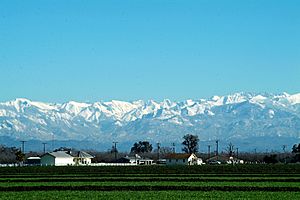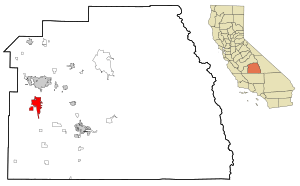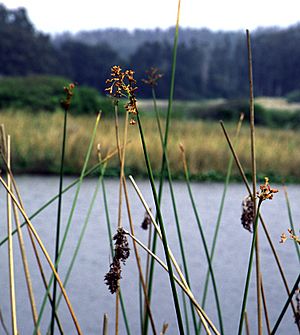Tulare, California facts for kids
Quick facts for kids
Tulare, California
|
|
|---|---|

View of Sierra Nevada mountains
|
|

Location in Tulare County and the state of California
|
|
| Country | United States |
| State | California |
| County | Tulare |
| Region | San Joaquin Valley |
| Incorporated | April 5, 1888 |
| Government | |
| • Type | Council/Manager |
| Area | |
| • Total | 20.46 sq mi (53.00 km2) |
| • Land | 20.39 sq mi (52.80 km2) |
| • Water | 0.08 sq mi (0.20 km2) 0.41% |
| Elevation | 289 ft (88 m) |
| Population
(2020)
|
|
| • Total | 68,875 |
| • Density | 3,212.95/sq mi (1,240.50/km2) |
| Time zone | UTC-8 (Pacific (PST)) |
| • Summer (DST) | UTC-7 (PDT) |
| ZIP codes |
93274, 93275
|
| Area code(s) | 559 |
| FIPS code | 06-80644 |
| GNIS feature IDs | 1652803, 2412107 |
Tulare is a city in Tulare County, California, United States. About 68,875 people lived there in 2020. It is in the middle of the San Joaquin Valley. Tulare is about 8 miles (13 km) south of Visalia. It is also 60 miles (97 km) north of Bakersfield. The city gets its name from Tulare Lake. This lake was once the biggest freshwater lake west of the Great Lakes.
Contents
What's in a Name? The Meaning of Tulare
The name Tulare comes from an old language called Nahuatl. The word was tōllin, which means "sedge" or "reeds." This word became tule in Spanish. You might even hear "tule" used in English today. It refers to a type of plant that looks like tall grass.
A Look Back: History of Tulare
Long ago, the Yokuts people lived here. They used reed boats and fished in what became Tulare Lake. Spanish and American pioneers later settled in the area. California became a state in 1850, but Tulare was not a town yet.
The city of Tulare started in 1872. It was founded by the Southern Pacific Railroad. The town was named after Lake Tulare. The lake got its name from the tule rush plant (shown left). These plants grew all around the lake's marshy shores.
The railroad was very important for the town at first. Tulare grew because it was the railroad's main office in the area. The town faced many tough times. It burned down and was rebuilt three times in its first 14 years! But it kept going and officially became a city in 1888.
In 1891, the railroad moved its main office to Bakersfield. This was a big blow to Tulare. Even without the railroad, the people of Tulare worked hard. They wanted to make their city a farming center, which it is today.
Tulare only gets about 10 inches (25 cm) of rain each year. So, they needed to find water. Citizens created the Tulare Irrigation District. They raised money to build a large system of canals. These canals brought water from the Sierra Nevada mountains. This water system helped Tulare grow a lot. It became a major center for farming.
In 1912, Hulett C. Merritt started Tagus Ranch. It was huge, about 7,000 acres (2,800 hectares). This made it the biggest fruit ranch in the world! Tagus Ranch produce was famous everywhere. During World War II, part of Tagus Ranch was used as a camp for German prisoners of war.
In 1940, a famous pilot named J.G. "Tex" Rankin opened a flying school in Tulare. It was called the Rankin Aeronautical Academy. This school trained pilots for the United States Army Air Corps during World War II. About 10,000 pilots learned to fly there.
During World War II, the Tulare County Fairgrounds became a temporary camp. It was called the Tulare Assembly Center. This was a place where Japanese Americans were held. Many of them were citizens born in the United States. They were moved there because of fears after the Attack on Pearl Harbor. Later, they were sent to larger, more permanent camps.
Tulare also hosted the National Championships for the Decathlon in Track and Field several times. These were in 1949, 1950, 1952, and 1962. The city also held the Olympic Trials for the Decathlon in 1952.
Where is Tulare? Geography and Climate
Tulare is located at 36°12′24″N 119°20′33″W. It is right between Fresno and Bakersfield. This puts it in the middle of the Central Valley. The Sierra Nevada mountains are about 20 miles (32 km) east. But you often can't see them because of the air pollution.
The city covers about 21 square miles (54 km²). Most of this area is land. Only a small part is water.
Weather in Tulare
Tulare has different weather throughout the year. Winters are cool and damp. The average temperature is about 45 degrees Fahrenheit (7°C). Summers are very hot and dry. Temperatures often reach 95 to 110 degrees Fahrenheit (35-43°C).
Tulare usually gets less than 2 inches (5 cm) of rain each year. This rain often falls during just one or two evenings. The Central Valley is one of the hottest places in California. Temperatures are often 80 degrees Fahrenheit (27°C) or higher for most of the year.
Tulare often has bad air quality all year. This is because of its location in a valley. Also, there's a lot of diesel exhaust from farms and trucks. Farming also creates a lot of dust, especially in late summer and fall.
Who Lives in Tulare? Demographics
| Historical population | |||
|---|---|---|---|
| Census | Pop. | %± | |
| 1880 | 447 | — | |
| 1890 | 2,697 | 503.4% | |
| 1900 | 2,216 | −17.8% | |
| 1910 | 2,758 | 24.5% | |
| 1920 | 3,539 | 28.3% | |
| 1930 | 6,207 | 75.4% | |
| 1940 | 8,259 | 33.1% | |
| 1950 | 12,445 | 50.7% | |
| 1960 | 13,824 | 11.1% | |
| 1970 | 16,235 | 17.4% | |
| 1980 | 22,530 | 38.8% | |
| 1990 | 33,249 | 47.6% | |
| 2000 | 43,994 | 32.3% | |
| 2010 | 59,278 | 34.7% | |
| 2020 | 68,875 | 16.2% | |
| U.S. Decennial Census | |||
In 2010, Tulare had 59,278 people. Most people lived in homes. About 61.3% of people were White. About 3.9% were African American. About 1.2% were Native American. About 2.2% were Asian. Many people, about 57.5%, were Hispanic or Latino.
There were 17,720 households. More than half of these had children under 18. The average household had about 3.33 people. The average family had about 3.68 people.
The median age in 2010 was 29.1 years. This means half the people were younger and half were older. About 33.3% of the people were under 18. About 9.0% were 65 or older.
Culture in Tulare
Tulare has many Portuguese residents. Many of them came from the Azores Islands. They started farms and dairies in the Central Valley. This helped create the famous farming boom in the 20th century.
How Tulare Makes Money: Economy
Tulare's economy mainly relies on farming and dairy. Tulare County has many dairy cows. These cows produce billions of pounds of milk each year. The largest dairy complex in the country is in Tulare. It is run by Land O'Lakes.
Tulare is home to the Tulare County Fair. This fair has been held since 1915. The city also hosts the World Ag Expo. This event happens every year in February. It is the biggest farming show in the world. Over 100,000 people from all over the world visit it.
Top Employers in Tulare
Here are some of the biggest employers in Tulare:
| # | Employer | Employees |
|---|---|---|
| 1 | Saputo Cheese USA, Inc. | 1,125 |
| 2 | Tulare City School District | 1,100 |
| 3 | Tulare Joint Union High School District | 667 |
| 4 | Land O'Lakes | 486 |
| 5 | City of Tulare | 381 |
| 6 | Adventist Health Hospital | 355 |
| 7 | Dreyer's Grand Ice Cream | 350 |
| 8 | Lactalis Heritage Dairy | 250 |
| 9 | Walmart | 212 |
| 10 | Twin Oaks Rehabilitation and Nursing Center | 189 |
Learning in Tulare: Education
Elementary and Middle Schools
The Tulare City School District runs many schools. There are 10 elementary schools. There are also five middle schools. Two schools teach students from kindergarten to 8th grade. Some elementary schools also have preschools. There is also a private K-8 school called St. Aloysius.
High Schools
High school education is provided by the Tulare Joint Union High School District. This district has five high schools in the city. These include Tulare Union and Tulare Western.
Colleges and Higher Education
Students in Tulare can go to two local community colleges. One is the College of the Sequoias in Tulare. The other is in nearby Visalia. The Tulare Center for Agriculture and Technology campus opened in 2013. It is expected to have 10,000 students by 2040.
Getting Around: Transportation
Tulare is located on California State Route 99. This is a major highway in California. Other state routes, 63 and 137, also serve the city.
Air Travel
Tulare has its own airport, Mefford Field. It has a runway that is 3,914 feet (1,193 meters) long. About 60 private planes are kept there. For bigger flights, you can go to airports in Fresno or Bakersfield.
Train Travel
Tulare is on the main line of the Union Pacific Railroad. There used to be another train line, but it has been turned into a walking and biking path.
Bus Travel
Tulare has a Greyhound bus station. You can send packages or travel to many places by bus. The city also has a local bus service called Tulare InterModal Express. It has set routes and a "Dial-A-Ride" service.
Awards and Recognition
Tulare has received several awards for its efforts.
In 2010, the city was recognized for its commitment to being sustainable. This means using resources wisely and protecting the environment. They made buildings more energy-efficient. They also had programs for solar power in homes.
In 2011, Tulare won the Climate Change Award. This was for its plan to use energy efficiently.
Also in 2011, a housing project in Tulare won two awards. It was called the Tule Vista Housing Development. This project helped provide housing for people.
Sister Cities
Tulare has "sister cities" in other parts of the world. These are cities that have a special friendship.
Famous People from Tulare
Many notable people have connections to Tulare:
- Jack Aker – A baseball player.
- Bryan Allen – A pilot who flew a plane powered by pedals.
- Bonnie Bryant – A golfer.
- The Charades – A popular music group from the 1960s.
- Matt Crafton – A NASCAR driver.
- Zac Diles – A professional football player.
- Dominique Dorsey – A professional football player.
- Jim Ellis – A professional baseball player.
- Hal Fowler – A poker player who won a world championship.
- Virgil Green – A professional football player who won the Super Bowl.
- Sim Iness – An Olympic gold medalist in discus.
- Odell Jones – A professional baseball player.
- Bob Mathias – A two-time Olympic decathlon gold medalist and U.S. Congressman.
- Mike Morgan – A professional baseball player who won the World Series.
- Rance Mulliniks – A professional baseball player.
- Lois Neilson – A silent movie actress.
- Devin Nunes – A U.S. Congressman.
- General Maurice A. Preston – A four-star Air Force general.
- Tex Rankin – A famous aerobatic pilot.
- Shirley Shahan – A pioneering drag racer.
- James Stallworth – A world record holder for the long jump in high school.
- Bob Veith – An auto racer.
- Marquess Wilson – A professional football player.
- Admiral Elmo R. Zumwalt, Jr. – A Chief of Naval Operations.
- Richard Torez – A boxer who won a silver medal at the Olympics.
See also
 In Spanish: Tulare (California) para niños
In Spanish: Tulare (California) para niños



